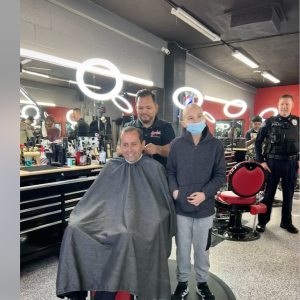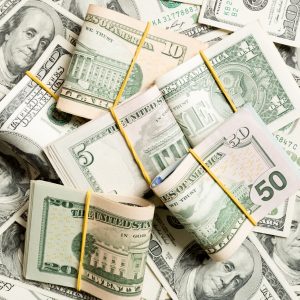 View Winners →
View Winners → March 2017 Art Column
By Jeff Davis
Christine Frerichs’ solo exhibition, “Beacon”, runs through April 15 at Klowdenmann in Culver City. The focus of her work revolves around color, light and landscapes to emote feelings, moods and meaning from time spent living and working in Los Angeles, New York and Tucson. Her abstract landscapes and symbolic portraits using wax, oil and other media on canvas are on display in the front room of the gallery and smaller wax on paper works are in the back.
The first eye catching painting encountered when entering the gallery is “Beacon” itself, a large 71” x 51” acrylic and oil on wood piece. The image is that of a sun placed high in the midday sky radiating brilliant light through the clouds below and heaven above. The light appears to ripple out from the center as if you are looking through a Fresnel lens of a lighthouse creating concentric multi-colored 8s swelling outward.
The eights take on the shape of a human body or consciousness with the sun assuming the position of the head of the abstract figure. The sun’s positioning in the painting creates a perspective as if you are looking upwards towards the sky. There is also a small green dot in the center lower third of the image that could represent the soul depending on your perspective. Unlike Frerichs’ previous work, “Beacon” is a more figurative / landscape oriented work as are several others including “Wet Moon, Clear Path (Tucson)” which also places the light source high in the painting to increase the sense of illumination.
My other favorite in the exhibit is “Bright Mist (Montauk), a large scale painting that is more subtle in terms of combining landscape components with the more abstract eights. There are gentle rolling waves at the bottom of the piece highlighted in blue, white, grey hues combined with aluminum leaf to add reflectivity. Above, once again are the calm undulating 8s or bodies adding to the serenity and depth of the waves below.
The majority of the other works in her exhibit are more abstract but equally engaging. They continue the same theme and style, incorporating the delicate shifts in color, repetitive brush strokes and figure eight icons of her earlier works. Quite a few of the paintings incorporate duality of eights with merging waves; perhaps signifying two souls interacting with each other.
The photos of her paintings don’t do them justice because they can’t capture her brush stroke texture and subtle changes in color that are displayed in person. Frerichs’ painting technique reminds me of Van Gogh or other impressionists that place hues of differing shades next to one another and let the human eye construct its own portrait. From afar your eye can easily assemble the eights and other forms and close up they are deconstructed into the individual components. Hundreds if not thousands of individual brush marks add up to form the image creating a sense of serenity, religion and humanity.
Don’t forget the project room in the rear of the gallery where a series of six smaller pieces on paper are displayed. They offer a different perspective to the brightly colored, aluminum flecked landscape works in the front room these focus solely on the figure eight. They begin with a darker graphite version of the figure eight or body allusion and slowly sift to a brighter glowing peach colored form.
These are really the type of paintings you want to sit in front of and meditate after a long day at work or a grueling drive home on the 110 or 405. Klowdenmann will hosting a conversation with the Frerichs at the gallery on March 25 at 4:30 p.m. – don’t miss it!
Just around the corner at Luis De Jesus Los Angeles they are showing Britton Tolliver’s “Powdered Toast” through March 25. The back room is filled with Tolliver’s abstract, brightly hued, medium -format works.
Tollivers’ new paintings still begin with a “Grid Base” seen in older works. That is to say the base layer of the paintings are a network of intersecting tile-like surfaces separated by paint grout that meet at either perpendicular planes or at varied angles. Some take on the look of traditional terra-cotta tiles and others are multi-colored paintings in themselves.
The next step is a random scraping away or carving through the base layer. This almost creates the appearance of rivers, causeways and natural barriers that were present before the grid was introduced – like the city of Manhattan or San Francisco forced to grow organically into the existing confined space. The final layer is a series of more random wedges of colors applied as if adding a multi- dimensional schmear of frosting to a section of the painting. This produces a color mesa upon the landscape. The mesas all have dramatic color shifts on the surface – an almost blurring effect – increasing their separation and elevation from the canvas level. It’s tempting to reach out and taste the schmear; but undoubtedly not a wise health decision.
Looking at the paintings gives one a sense that they are viewing a city map, topographical overview or satellite image of some sort. The satellite image effect magnifies the color range and brightness of the sections – making the works burst like a digital photo. The paintings do an amazing job of combing the influence of the digital and organic worlds on the canvas.
Other Opportunities:
Museum of Tolerance: “Anne”
“Anne” is an immersive exhibit on the life and legacy of Anne Frank. Anne’s story, told in her own words, comes to life through rare artifacts, unique documents, and photographs. Visitors view a facsimile of her famous diary and several other examples of her original writing that culminated in what has become one of the most famous and well-read books ever. The exhibit highlights little known facts about her time in hiding and the events that led to her arrest. Hear first-hand accounts about Anne from the people who knew her.








































































































